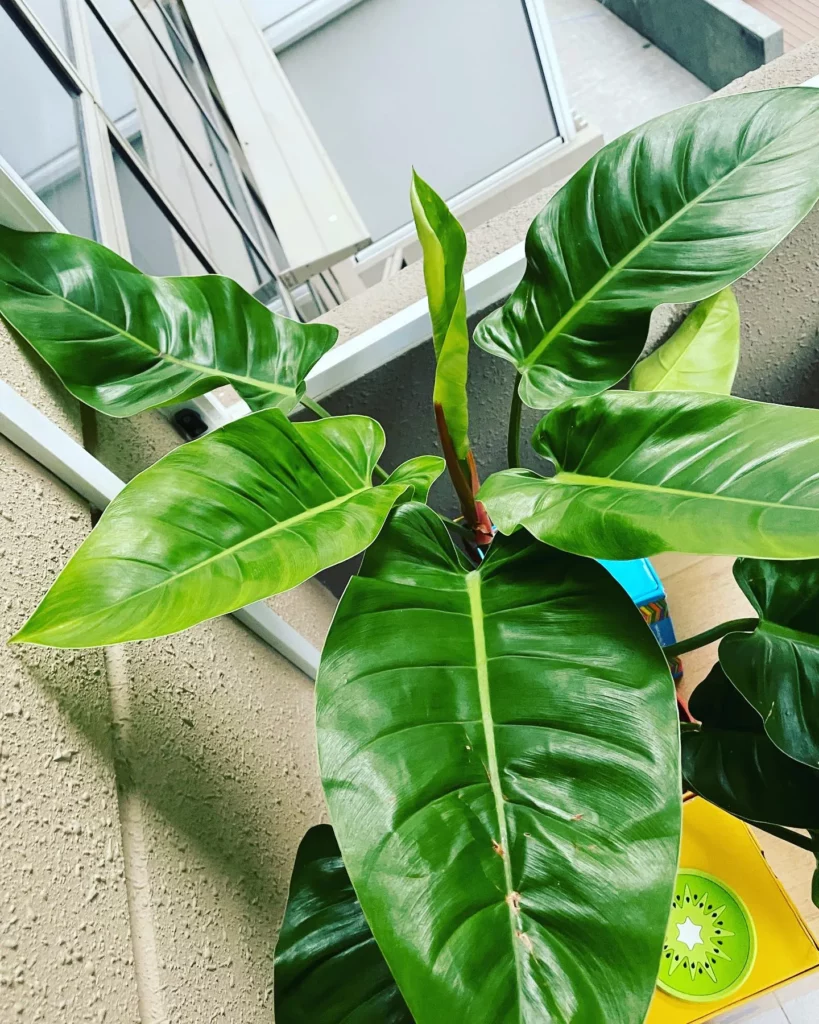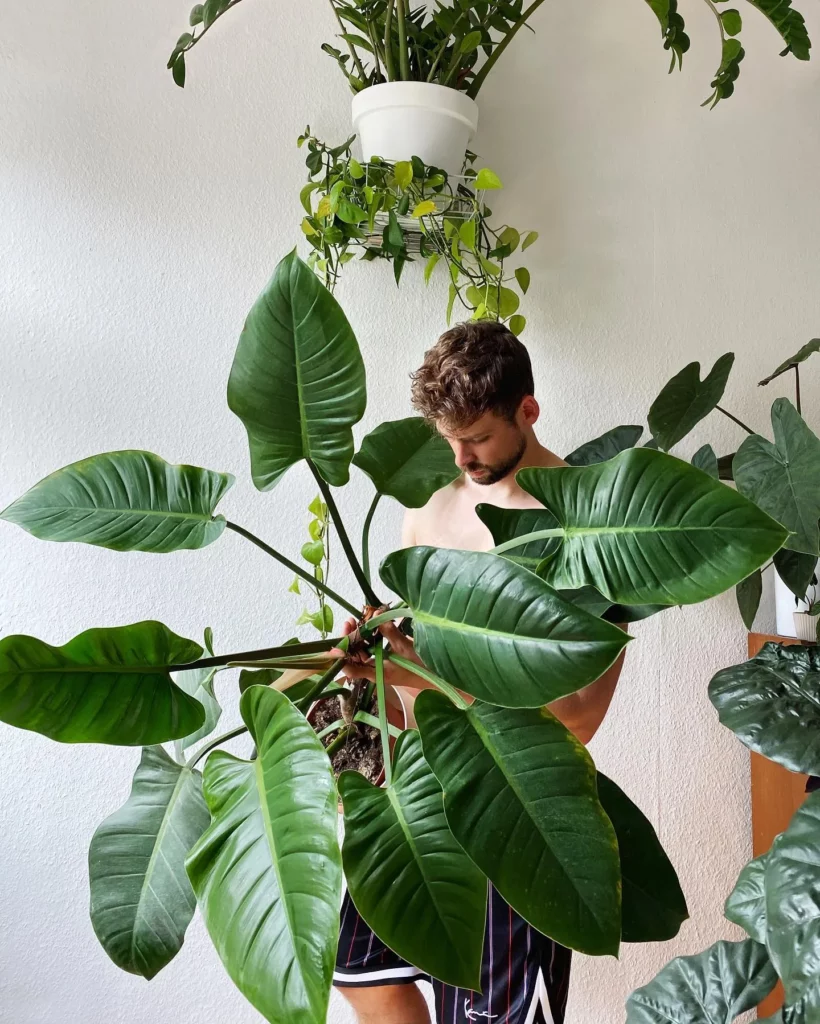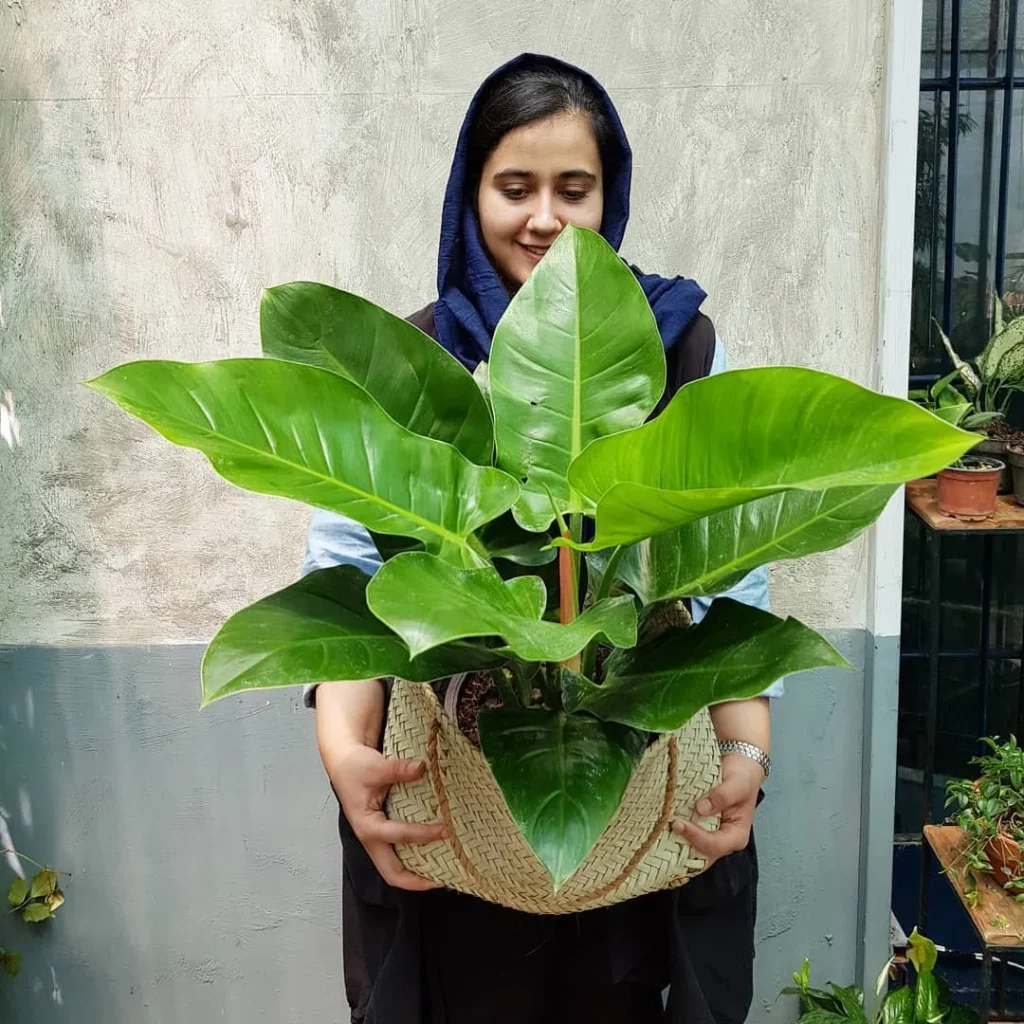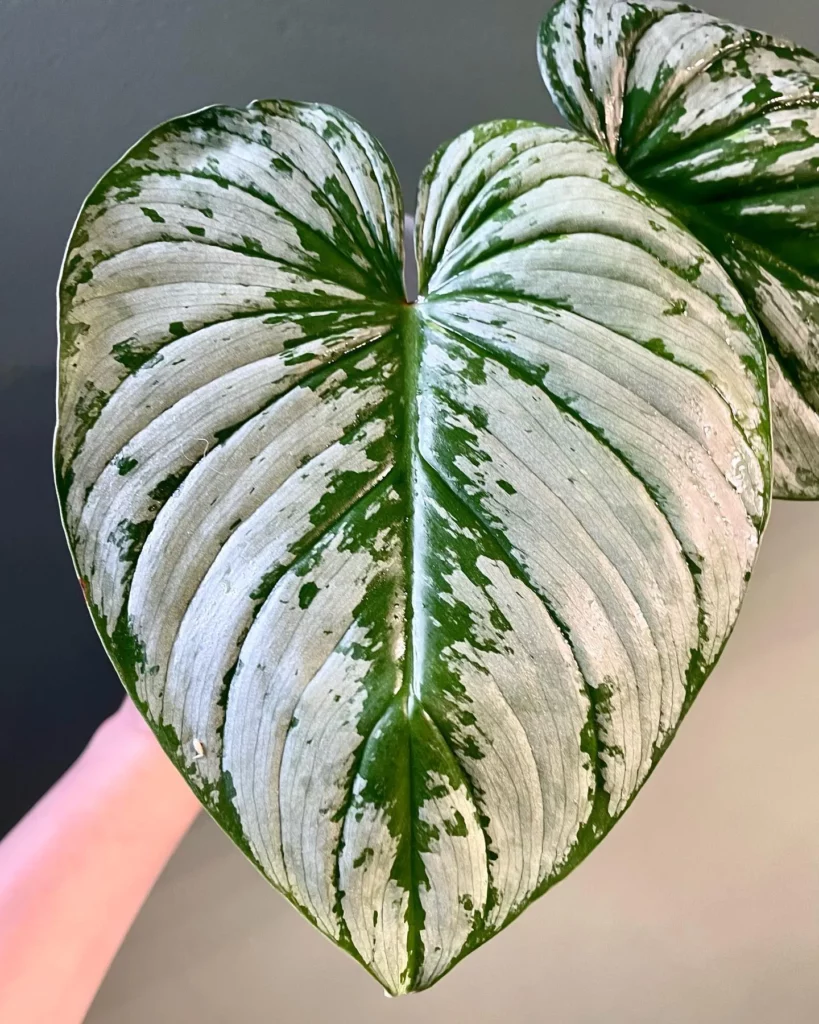Welcome to our guide on growing tips for the Philodendron Imperial Green. This popular houseplant is not only visually appealing with its glossy green leaves, but it also has the added benefit of improving indoor air quality. In this article, we will provide you with all the information you need to ensure the health and growth of your Philodendron Imperial Green.
Key Takeaways:
- Provide the Philodendron Imperial Green with moderate to bright, indirect sunlight.
- Repot annually when the roots start growing out of the drainage holes.
- Propagate through stem cuttings by submerging the bottom part in water or planting it directly in well-draining soil.
Appearance of Philodendron Imperial Green



The Philodendron Imperial Green is a stunning houseplant that will add a touch of tropical elegance to any indoor space. With its large, dark green leaves that are smooth and glossy, this plant has an alluring appearance that is reminiscent of elephant ears. The glossy sheen of the leaves enhances the lush and vibrant look of the plant, making it a true showstopper.
Standing tall and upright, the Philodendron Imperial Green can reach a height of around 90 to 120cm when grown indoors. Its compact size makes it a perfect choice for smaller homes and offices, where it can be used as a statement piece or as part of a green ensemble. Its low-maintenance nature means that it is easy to care for, making it ideal for both experienced plant enthusiasts and beginners alike.
Light Requirements for Philodendron Imperial Green



The Philodendron Imperial Green is a hardy houseplant that thrives in moderate to bright, indirect sunlight. It can adapt to lower light conditions, but direct sunlight should be avoided as it can scorch the leaves. To ensure optimal growth, place your Philodendron Imperial Green near a window with dappled light throughout the day. This will provide the plant with the right amount of light it needs to flourish.
If you don’t have access to natural light, you can supplement with artificial grow lights or fluorescent lights. These can help mimic the brightness and spectrum of natural sunlight, allowing your Philodendron Imperial Green to receive the necessary light for healthy growth. Position the lights above the plant, ensuring they are not too close to avoid burning the leaves.
Watering Tips for Philodendron Imperial Green



Proper watering is essential for the health and well-being of your Philodendron Imperial Green. Maintaining the right level of soil moisture will help ensure optimal growth and prevent common watering-related problems.
To water your Philodendron Imperial Green effectively, follow these tips:
- Check the soil moisture regularly by inserting your finger into the soil up to the second knuckle. If the top 1-2 inches of soil feel dry, it’s time to water.
- Avoid overwatering the plant. It’s better to underwater than overwater, as Philodendrons are more tolerant of dry conditions than excessive moisture. Allow the soil to slightly dry out between waterings to prevent root rot.
- When watering, ensure you thoroughly soak the entire root ball. This allows the roots to absorb water and encourages healthy growth.
- Use room temperature or slightly warm water to prevent shock to the plant.
- Avoid letting the plant sit in standing water, as this can also lead to root rot. Make sure your pot has drainage holes to allow excess water to escape.
Fertilizing Philodendron Imperial Green



Fertilizing your Philodendron Imperial Green 2-3 times during the spring and summer growing season can help promote healthy growth. It’s important to use a balanced liquid fertilizer and dilute it to a weaker solution to avoid over-fertilization. Applying the fertilizer once or twice a month is sufficient for providing your plant with the nutrients it needs.
If you prefer using a foliar fertilizer, you can spray it directly onto the leaves of your Philodendron Imperial Green. This method ensures that the plant can absorb the nutrients efficiently through its foliage. However, make sure to read the instructions on the fertilizer package for specific guidelines on dilution ratios and application frequency.
Potting Philodendron Imperial Green



Proper potting is essential to ensure the healthy growth and development of your Philodendron Imperial Green. Repotting should be done when the roots start growing out of the bottom drainage holes of the current pot. Typically, this occurs on an annual basis, although it may vary depending on the plant’s growth rate and size.
When selecting a new pot, choose one with drainage holes to prevent waterlogged soil, which can lead to root rot. A well-draining soil mix is crucial for the Philodendron Imperial Green’s overall health. Consider using a combination of potting soil and perlite or a mixture of coco coir, orchid mix, and perlite.
Before potting, it’s important to sterilize the soil to eliminate any potential pathogens or pests. This step helps minimize the risk of disease and ensures a clean and healthy environment for your plant to thrive.
Propagating Philodendron Imperial Green



If you want to expand your collection of Philodendron Imperial Green or share this beautiful plant with friends and family, you can easily propagate it through stem cuttings. Here is a step-by-step guide to help you successfully propagate your Philodendron Imperial Green:
- Start by selecting a healthy stem that is at least 3 to 6 inches long. Make sure the stem has a few leaves.
- With clean, sharp scissors or pruning shears, cut the stem just below a node, which is the point where a leaf is attached to the stem.
- You have two options for propagating: water propagation or soil propagation.
- If you choose water propagation, place the bottom part of the cutting in a vase or glass of water. Make sure the cut end is submerged but the leaves are not touching the water. You can use a small piece of tape or a paperclip to support the cutting and keep it in place.
- If you prefer soil propagation, plant the cutting directly in a well-draining soil mix. Use a pencil or your finger to make a hole in the soil and gently insert the cutting, making sure the cut end is covered with soil.
- Regardless of the propagation method you choose, it’s important to create a humid environment for the cutting. You can achieve this by covering the cutting with a plastic bag or a small transparent container. This will help to maintain the humidity and prevent excess moisture loss.
- Place the cutting in an area with bright, indirect light. Direct sunlight can be too intense and may cause the leaves to burn.
- Check the cutting regularly and mist the leaves to keep them hydrated. If you are water propagating, make sure to change the water every few days to prevent stagnation.
- After about 3 to 4 weeks, roots should start to develop. You can gently tug on the cutting to check for resistance, indicating that roots have formed.
- Once the roots are well-established, you can remove the cutting from water or transplant the rooted cutting into a small pot with well-draining soil.
- Continue to care for the propagated plant following the regular care guidelines for Philodendron Imperial Green.
Growth and Development of Philodendron Imperial Green


The Philodendron Imperial Green is a moderate to fast-growing plant that can reach a height of around 90 to 120cm indoors. With proper care and the right conditions, such as adequate light, watering, and fertilizing, the plant will experience healthy growth.
Providing your Philodendron Imperial Green with sufficient light is crucial for its growth and development. Place it in a location with moderate to bright, indirect sunlight to ensure optimal photosynthesis. Avoid exposing the plant to direct sunlight, as it may cause the leaves to burn.
Watering the Philodendron Imperial Green appropriately is essential to support its growth. Keep the soil moderately moist by watering it when the top layer feels dry. However, be cautious not to overwater, as this can lead to root rot. Check the soil moisture regularly by feeling the top layer with your fingers.
Fertilizing your Philodendron Imperial Green during the spring and summer growing season will provide it with the nutrients necessary for healthy development. Use a balanced liquid fertilizer and dilute it to a weaker solution to prevent over-fertilization. Apply the fertilizer once or twice a month, following the instructions on the package.
In addition to light, water, and fertilizer, regular pruning can aid in the growth and maintenance of your Philodendron Imperial Green. Trim away dead or damaged leaves to encourage new growth and maintain an attractive appearance. Pruning also helps prevent the plant from becoming overcrowded.
Pests and Diseases of Philodendron Imperial Green
The Philodendron Imperial Green is a resilient plant that is relatively pest-resistant. However, it is still important to be vigilant for common pests and diseases that can affect its health. By regularly inspecting your plant, you can catch any issues early and take appropriate action to protect its well-being.
Common Pests
Despite its hardiness, the Philodendron Imperial Green can be susceptible to infestations by pests such as mealybugs, scale, and spider mites. These pests can cause damage to the leaves and overall plant health if left untreated.
Signs of Infestation
When inspecting your Philodendron Imperial Green, keep an eye out for signs of pest infestation. Look for yellow spots on the leaves, holes in the foliage, or sticky residue on the plant’s surface. These are all indications that pests may be present.
Controlling Pests
If you notice signs of pest infestation on your Philodendron Imperial Green, it’s important to take action promptly. You can remove pests manually by wiping them off with a soft cloth or cotton swab. Alternatively, you can use natural pest control methods such as neem oil or insecticidal soap. Be sure to follow the instructions carefully when using any pest control products and avoid overusing them, as it can harm the plant.
Diseases and Root Rot
In addition to pests, the Philodendron Imperial Green can be prone to root rot if over-watered. Root rot is a fungal disease that can cause the roots to decay, leading to wilting, yellowing leaves, and stunted growth. To prevent root rot, it’s essential to maintain proper watering practices. Allow the top layer of soil to dry out slightly between waterings, and always ensure good drainage in the pot.
Toxicity of Philodendron Imperial Green
The Philodendron Imperial Green is a beautiful and popular houseplant, but it’s important to be aware that it is toxic to humans and pets if ingested. The plant contains a chemical called calcium oxalate, which can cause irritation and swelling of the mouth, throat, and digestive system. To ensure the safety of your loved ones, it’s crucial to keep the plant out of reach of children and pets.
When handling the Philodendron Imperial Green, it’s recommended to wear gloves to avoid any contact with the sap, which can also cause skin irritation. If you or your pet accidentally come into contact with the plant or ingest any part of it, seek medical attention immediately.
Care Tips Recap for Philodendron Imperial Green
To ensure the health and prosperity of your Philodendron Imperial Green, it’s important to follow these care tips:
1. Provide moderate to bright, indirect sunlight: Place your Philodendron Imperial Green near a window with dappled light throughout the day. Avoid exposing it to direct sunlight, as it can damage the leaves.
2. Water when the top layer of soil is dry: Allow the top 1-2 inches of soil to slightly dry out before watering again. Overwatering can lead to root rot, so it’s best to check the soil moisture with your fingers.
3. Fertilize 2-3 times during the growing season: Use a balanced liquid fertilizer and dilute it to a weaker solution. Apply the fertilizer once or twice a month for optimal growth.
4. Repot when roots start growing out of the drainage holes: Philodendron Imperial Green generally needs to be repotted on an annual basis. Choose a pot with drainage holes and a well-draining soil mix to ensure proper growth.
5. Propagate through stem cuttings: Take healthy stem cuttings that are 3 to 6 inches long and have a few leaves. Plant them in water or a well-draining soil mix, keeping them humid until roots develop.
6. Mind common pests and diseases: Regularly inspect your Philodendron Imperial Green for signs of pests like mealybugs or spider mites. Remove them manually or use natural pest control methods. Additionally, be cautious of root rot caused by overwatering.
FAQ
How do I care for a Philodendron Imperial Green?
To care for a Philodendron Imperial Green, provide it with moderate to bright, indirect sunlight, water it when the top layer of soil is dry, fertilize it 2-3 times during the growing season, repot it when the roots start growing out of the drainage holes, propagate it through stem cuttings, and be mindful of common pests and diseases.
What does a Philodendron Imperial Green look like?
The Philodendron Imperial Green has large, dark green leaves that are smooth and glossy. The leaves are shaped like elephant ears and give the plant a tropical and lush appearance. The plant grows upright and can reach a height of around 90 to 120cm indoors.
What are the light requirements for a Philodendron Imperial Green?
The Philodendron Imperial Green thrives in moderate to bright, indirect sunlight. It can tolerate shadier surroundings, but direct sunlight should be avoided as it can cause the leaves to burn. Placing the plant near a window with dappled light throughout the day is ideal. Supplementing with artificial grow lights or fluorescent lights can also help provide the necessary light for healthy growth.
How often should I water a Philodendron Imperial Green?
It is important to keep the soil of your Philodendron Imperial Green moderately moist. Allow the top 1-2 inches of soil to slightly dry out between waterings before watering again. Overwatering can be detrimental to the plant, so be cautious not to water it too frequently.
How often should I fertilize a Philodendron Imperial Green?
Fertilizing your Philodendron Imperial Green 2-3 times during the spring and summer growing season can help promote healthy growth. Use a balanced liquid fertilizer and dilute it to a weaker solution to avoid over-fertilization. Applying the fertilizer once or twice a month is sufficient.
When should I repot my Philodendron Imperial Green?
Repotting your Philodendron Imperial Green should be done when the roots start growing out of the bottom drainage holes. This typically happens on an annual basis, but can vary depending on the growth rate and size of the plant.
How can I propagate a Philodendron Imperial Green?
The Philodendron Imperial Green can be propagated through stem cuttings. Cut a healthy stem that is at least 3 to 6 inches long and has a few leaves. Submerge the bottom part of the cutting in water or plant it directly in a well-draining soil mix. Cover the cutting with plastic to maintain humidity and wait for the roots to grow, which typically takes around 3 to 4 weeks.
How fast does a Philodendron Imperial Green grow?
The Philodendron Imperial Green is a moderate to fast-growing plant that can reach a height of around 90 to 120cm indoors. With proper care and the right conditions, such as adequate light, watering, and fertilizing, the plant will experience healthy growth.
What pests and diseases should I watch out for with a Philodendron Imperial Green?
The Philodendron Imperial Green is relatively pest-resistant, but it can still be susceptible to common houseplant pests such as mealybugs, scale, and spider mites. Regularly inspect the plant for signs of infestation, such as yellow spots or holes in the leaves. The plant can also be prone to root rot if over-watered, so it’s important to maintain proper watering practices.
Is the Philodendron Imperial Green toxic?
Yes, the Philodendron Imperial Green is toxic to humans and pets if ingested. The plant contains a chemical called calcium oxalate, which can cause irritation and swelling of the mouth, throat, and digestive system. It is important to keep the plant out of reach of children and pets, and to handle it with care to avoid any contact with the sap.
What are the care tips for a Philodendron Imperial Green?
To care for your Philodendron Imperial Green, provide it with moderate to bright, indirect sunlight, water it when the top layer of soil is dry, fertilize it 2-3 times during the growing season, repot it when the roots start growing out of the drainage holes, propagate it through stem cuttings, and be mindful of common pests and diseases. Remember that the plant is toxic and should be kept out of reach from children and pets.




